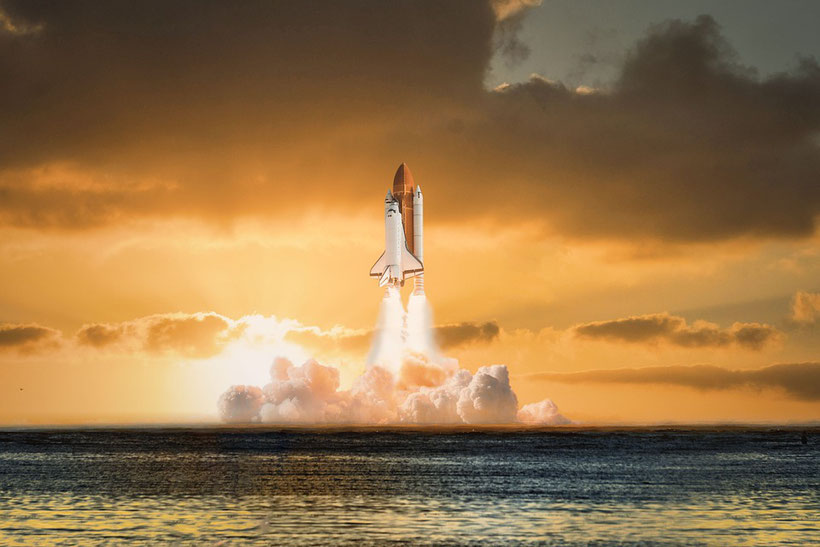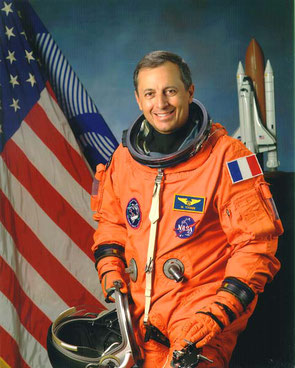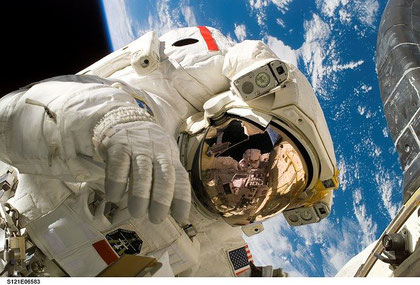

Il est des aventures qui font rêver ? Celle de l’Espace en est une. MICHEL TOGNINI est un des rares astronautes français à avoir volé avec les Russes avec la mission Soyouz et les américains sur Columbia.
Après avoir été le chef de la division des astronautes européens, il a été le chef du Centre des astronautes européens de l'Agence spatiale européenne à Cologne
en Allemagne. Il est maintenant en France pour défendre les vols habités auprès du grand public et pour aider les universités pour les travaux sur l'exploration spatiale habitée.
Il est le président du Groupement aéronautique du ministère de l'Air (Gama), membre du conseil d'administration de la fondation Van Allen avec l'université de Montpellier.
Author photo Par NASA — http://www.jsc.nasa.gov/Bios/htmlbios/tognini.html, Domaine public, https://commons.wikimedia.org/w/index.php?curid=2428016
Sa place de chef du Centre des astronautes européens lui a également permis de recruter Thomas Pesquet et Sophie Adenot.
MICHEL TOGNINI parlera de la chance qu’il a su prendre au vol au-delà du travail acharné pour vivre son rêve, et de la vie à bord de l’équipage dans un univers si difficile et contraignant ! Au-delà des succès, Michel fait la part belle à l’échec qu’il faut respecter. Une belle histoire d’humanité.
• la confiance est un voyage et non une destination
• l’échec n’est pas une option
Séquence 1 : DECOLLONS ENSEMBLE
Objectif de cette partie : séquence émotion pour entrer dans cet univers et rêver
• 1ère mission - Soyouz en 1992
o Stotytelling avec des photos
• 2ème mission - Columbia en 1999
o storytelling avec un film et des photos
Séquence 2 : BREVE HISTOIRE DE L’ESPACE
• Une courte histoire de l'Espace : de la confrontation à la coopération
o La confrontation avec le 1er homme sur la lune
o La station ISS pour préparer les missions futures
• Une vision commune : le drapeau Terre sur la lune :
o L’importance d’une vision partagée
o L’importance des liens humains
• Et demain ?
o Aller sur Mars pour trouver de la vie
o Aller sur un astéroïde pour le dévier de la Terre
o Les points de Lagrange pour des observations précises
o Les différentes missions scientifiques
• Des conditions de vie difficiles
o lors des différentes phases - décollage, vol et atterrissage
o Conviction : adaptation de l'être humain
• Un écosystème contraignant
o Les limites du matériel
o Le milieu hostile
o Le recyclage
Séquence 4 : L’ÉQUIPAGE, L'ESPRIT D’ÉQUIPE ET LE MANAGEMENT DES HOMMES
• Les rôles des 6 membres de l'équipage : les -responsabilités dans la station et dans la fusée
• La polyvalence
• Les conséquences sur le recrutement
• Les conséquences sur l'entrainement
• le leader
o les qualités du leader : être un bon n°2 avant d'être un n°1, être un bon follower
o l'entrainement au leadership au sol
Séquence 5 : LA GESTION DES RISQUES ET DE L’ÉCHEC
• Récit sur les 3 incidents Columbia, Challenger, Apollo : quel management du risque ?
Séquence 6 : LE MANAGEMENT A DISTANCE
CONCLUSION
• L’espace, une histoire qui continue de s’écrire : quelques projets
• Les messages clefs :
o notre adaptation est très importante et dépasse ce que l’on imagine
o je crois au travail (versus intelligence)
o l’échec n’est pas une option : il est là pour nous faire avancer
o la confiance est un chemin et non une destination
o les projets transversaux peuvent réussir, avec la vision, la volonté et la confiance
D'autres thématiques peuvent etre abordées comme l'ESG/durabilité/changement climatique/environnement/alimentation/biodiversité/durabilité, Social et Gouvernance
****************************************************************************

After serving as the head of the European Astronaut Division, MICHEL TOGNINI served as the head of the European Space Agency's
European Astronaut Center in Cologne, Germany. He is now in France to defend manned flights to the general public and to help universities with work on manned space exploration.
He is the president of the Aeronautical Group of the Ministry of Air (Gama), member of the board of directors of the Van Allen Foundation with the University of Montpellier.
His position as head of the European Astronaut Center also enabled him to recruit Thomas Pesquet & Sophie Adenot.
Born 30 September 1949, in Vincennes, France. Four children. Enjoys parachuting and parafoil, tennis, windsurfing, water-skiing, snow-skiing, cross-country running, wave-surfing, discus launch
gliders and computers.
2 Presentation major convictions that MICHEL TOGNINI wishes to share with you :
• trust is a travel, not a destination
• failure is not an option
Sequence 1 : TAKE OFF TOGETHER Objective of this part: emotion sequence to enter this universe and dream • 1st mission - Soyuz in 1992 o Stotytelling with photos • 2nd mission - Columbia in 1999 o storytelling with a film and photos
Sequence 2 : A BRIEF HISTORY OF SPACE • A short history of Space: from confrontation to cooperation o The confrontation with the 1st man on the moon o The ISS station to prepare future missions • A common vision: the Earth flag on the moon: o The importance of a shared vision o The importance of human connections • And tomorrow ? o Go to Mars to find life o Jump on an asteroid to deflect it from Earth o Lagrange points for precise observations o The different scientific missions
Sequence 3 : LIFE ON BOARD • Difficult living conditions o during the different phases - take-off, flight and landing o Conviction: adaptation of the human being • A constraining ecosystem o Hardware limitations o The hostile environment o Recycling
Sequence 4 : CREW, TEAM SPIRIT AND PEOPLE MANAGEMENT • The roles of the 6 crew members: responsibilities in the station and in the rocket • Versatility • Consequences on recruitment • Consequences on training • the leader o the qualities of the leader: to be a good n°2 before being a n°1, to be a good follower o ground leadership training
Sequence 5 : RISK AND FAILURE MANAGEMENT • Account of the 3 incidents Columbia, Challenger, Apollo: what risk management ?
Sequence 6 : REMOTE MANAGEMENT. Having practiced both sides of this type of management: astronaut in flight while the manager is on the ground, then himself responsible for European astronauts while the astronauts were in flight.
CONCLUSION
• Space, a story that continues to be written: a few projects
• Key messages: o our adaptation is very important and goes beyond what we imagine o I believe in work (versus intelligence)
o failure is not an option: it is there to move us forward o trust is a path, not a destination
o transversal projects can succeed, with the vision, the will and the confidence
Other themes can be addressed such as ESG/sustainability/climate change/environment/food/biodiversity/sustainability, Social and Governance
Education
Graduated from the Lycée de Cachan, Paris. MICHEL TOGNINI received an advanced mathematics degree in 1970 from EPA Grenoble (military
school). He enrolled at Ecole de l’air (French Air Force Academy), Salon de Provence, France, graduating with an engineering degree in 1973. Tognini attended the Empire Test Pilots School,
Boscombe Down, United Kingdom in 1982 and the Institut des Hautes Etudes de Défense Nationale (IHEDN) in 1993-1994.
He is a Général de brigade aérienne (French Air Force).
He gained qualifications as Fighter Pilot (all levels), Test Pilot, and Professional Pilot, he received Military Technical Diploma (BTEM) and the Cosmonaut diploma from the Soviet Union. He was
awarded the NASA Spaceflight Medal and the V.M. Komarov Diploma (FAI). He received the Hawker Hunter Trophy and the Patuxent Shield Trophy from ETPS Boscombe Down.
Organisations
Member of the Association of Space Explorers (ASE).
Special honours
Michel Tognini is Commander of “l’Ordre de la Légion d’Honneur”, “Chevalier de l’Ordre National de Mérite”, he received the French Aeronautics Medal, and the Soviet and Russian “Order of
Friendship”. He got the NASA Spaceflight Medal and the V.M. Komarov Diploma (FAI). He received the Hawker Hunter Trophy and the Patuxent Shield Trophy from ETPS Boscombe Down.
Experience
Following graduation in 1973 from the Ecole de l’Air, and qualifying as a fighter pilot in 1974, Tognini was posted to a fighter squadron stationed at Cambrai, where he served as flight leader in
1976, and flight commander in 1979. In 1982 he was admitted to the Empire Test Pilot School in Boscombe Down, United Kingdom, and received his test pilot diploma. He was awarded his military
studies diploma in 1983. Tognini was then posted to the Cazaux Flight Test Center, France, and qualified as chief test pilot.
In September 1985, Tognini was selected as astronaut by the French Space Ageny CNES. In August 1986, he was assigned as the back-up for the Soyuz TM-7 mission. Although Tognini remained a French
Air Force officer, he was placed on detachment to CNES for his space flight activities from September 1986 onwards.
In November 1986 he reported to the Yuri A.Gagarin Cosmonaut Training Center, Star City, near Moscow, for alternate astronaut training, including spacewalk training, for the Soviet-French
“Aragatz” mission. During 1989-1990 he supported the HERMES program in Toulouse, France.
In 1991 he returned to Star City, Russia, to start prime crew training for the 3rd French-Russian “Antares” mission, which took place from 27 July to 10 August 1992. During this stay, he also
gained piloting experience of BURAN simulators. After his mission, he returned to France and attended a training cycle of the French Institute for High Studies of National Defense from
1993-1994.
In 1995, he took up Astronaut Candidate Training at the NASA Johnson Space Center in Houston/USA. He was initially assigned to the Operations Planning Branch of the Astronaut Office working
technical issues on the International Space Station.
MICHEL TOGNINI has prepared around 250 papers, presentations, speeches and conferences about Human Spaceflight.
Michel has 4300 flight hours on 80 types of aircraft.
In November 1999, Michel Tognini joined the European Astronaut Corps based at the European Astronaut Center in Cologne, Germany.
His duty station remained at the NASA Johnson Space Center, where he performed technical duties in the International Space Station Robotics Branch supporting the Mobile Base System and the
European Robotic Arm. He was also assigned to training support for the Shuttle and robotics as well as for the ExCan training of International Space Station crews (part of the Expedition Corps
Working Group). In 2001 he worked as a Space Station Capcom, and joined the Station's branch for Russian hardware and training/payload of Soyuz in the Russian segment as well as for European COF
training.
From May 2003 to December 2004, Michel was Head of the Astronaut Division at the European Astronaut Centre.
Spaceflight experience
Tognini participated in the “Antares” mission from 27 July to 10 August 1992. This was his first flight to the Russian space station Mir, where he spent 14 days carrying out a programme of
Soviet-French experiments.
His second flight was on STS-93 which took place from 22-27 July 1999. During this mission his primary task was to assist in the deployment of the Chandra X-Ray Observatory, and to conduct a
spacewalk if needed. The Chandra X-Ray Observatory is designed to conduct comprehensive studies of the universe. The telescope enables scientists to study exotic phenomena such as exploding
stars, quasars, and black holes.
Current assignment
In January 2005, Michel became Head of the European Astronaut Centre in Cologne, Germany. He left ESA for retirement on 1 November 2011.
topics also asESG/sustainability/climate change/environment/food/biodiversity/sustainability









